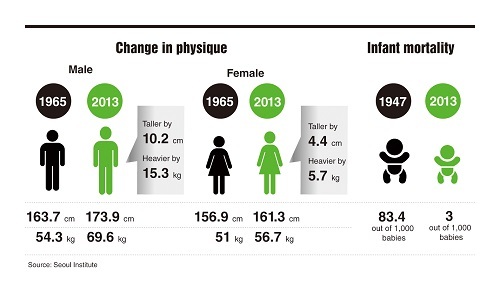In the span of seven decades since liberation from Japan’s colonial rule, citizens in South Korea’s capital have gone through prominent physical changes, while the main causes of death have also become different, a report showed this week.
In 1965, the average height of men living in Seoul stood at 163.7 centimeters, weighing in at 54.3 kilograms. Some 50 years later in 2013, the average height has grown to 173.9 cm, and weight to 69.6 kg.
Women were also shorter five decades ago at 156.9 cm, and lighter at 51 kg, compared to 2013’s 161.3 cm and 56.7 kg.
These points and other data were gathered by the Seoul Institute, a research center for the Seoul Metropolitan Government, on the occasion of the 70th anniversary of Liberation Day this month.

The main causes of death also drastically changed during over the 60 years, the report said.
While the largest number of deaths were caused by pneumonia (12.6 percent) and infant diseases (12 percent) in 1947, cancer (31 percent), cerebrovascular diseases (8.7 percent) and heart problems (7.9 percent) caused the most deaths in 2013.
Life expectancy, meanwhile, greatly increased, from 42.8 years for men and 47.1 years for women in 1942 to 78.5 years and 85 years, respectively, in 2013.
The number of births in Seoul, on the other hand, declined, from 37.3 per 1,000 in 1947 to 8.4 in 2013.
Infant mortality reduced from 83.4 of 1,000 babies dying before the age of 1 to 3 of 1,000 in the same time period.
While nearly all, or 99.3 percent, of babies were born at home in 1947, most, or 98.8 percent, were born at hospitals 66 years later.
From news reports

